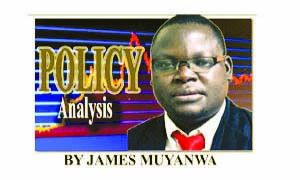AT the risk of turning this forum into an International Monetary Fund (IMF) debate platform, it has, once more, continued debating the IMF engagement by Zambia.
Obviously, at this juncture the question of whether Zambia needs an IMF bailout package or not has already been effectively answered.
In fact it was answered way back because the country has been clamouring for it for nearly a decade now.
That was upon realising that the country was headed for a serious financial crisis caused mainly by excessive borrowing.
This is because Zambia’s heavy debt burden has wreaked havoc on socio-economic situation in the recent years.
The question, therefore, whether the Government has made a mistake in pursuing the IMF programme or not does, not arise!
This is against the backdrop of the dismal economic performance the country has been recording in the last seven to 10 years.
This forum has featured article on the topic of IMF and Zambia for myriad times and using expert information it has answered the question of whether Zambia needs an IMF package or not.
As Finance minister, Situmbeko Musokotwane said in Parliament last week, maintaining the status quo is not among the available options.
For instance, the dear Kwacha has weakened from less than K5/ United States (US) dollar around 2011 to more than K20/ US dollar this year.
Similarly, inflation has risen from a single digit to double digit, compounded by closure of some businesses due to lack of demand.
Generally, the excessive external debt servicing has been draining money away from Zambia, leading to its failure to employ public workers like teachers.
Dr Musokotwane says that in the 2022 National Budget, for example, the amount of money needed to pay public workers’ salaries and service the debt exceeds the revenues to be collected by the Government.
Therefore, the remaining relevant questions should hinge on benefits, actual implementation, some pitfalls or risks, some possible ways of best implementing the programme and the like.
It is equally important to note that IMF has a number of programmes which can be offered to its member countries Zambia’s position, depending on the country’s economic stage and aspiration.
For some reasons, which will be demonstrated later, the Zambian government has prioritised getting an Extended Credit Facility (ECF) from the fund to stabilise the economy.
In terms of working arrangement, this is in addition to IMF’s routine surveillance under the famous Article IV of the Articles of Agreement of the IMF to which Zambia is a party.
But what does the IMF ECF, which Zambia has prioritised to get, entail?
According to an IMF write-up of March 3, 2020, the ECF provides financial assistance to countries with protracted balance of payments problems, like Zambia.
The ECF was created under the Poverty Reduction and Growth Trust (PRGT) as part of a broader reform to make the fund’s financial support more flexible and better tailored to the diverse needs of low-income countries (LICs), including in times of crisis.
The ECF is the fund’s main tool for providing medium-term support to LICs.
According to the fund, the ECF supports countries’ economic programmes aimed at moving toward a stable and sustainable macroeconomic position.
This should be consistent with strong and durable poverty reduction and growth.
Zambia is, currently, in that position.
The ECF may also help catalyse additional foreign aid.
In terms of eligibility, the ECF is available to all PRGT-eligible member countries, like Zambia, that face a protracted balance of payments problem.
These are countries whose resolution of the underlying macroeconomic imbalances would be expected to extend over the medium or longer term.
To resolve Zambia’s economic malaise you need more than two years.
The assistance under an ECF arrangement is provided for an initial duration of three to up to five years, with an overall maximum duration of five years.
In Zambian case, if approved, the fund will make available highly concessional loans amounting to $1.4 billion to be disbursed over a period of three years, most likely effective 2022.
After the expiration, cancellation, or termination of an ECF arrangement, additional ECF packages may be approved.
The IMF indicates that access to ECF financing is determined on a case-by-case basis, taking into account the country’s balance of payments need, the strength of its economic programme and capacity to repay the fund, among other issues.
Under the ECF, member countries agree to implement a set of policies that will help them make progress toward a stable and sustainable macroeconomic position over the medium term.
These commitments, including specific conditions, are described in the country’s letter of intent and are usually a source of controversy from the citizens and other stakeholders.
The IMF’s programme conditionality is a thorny issue which is streamlined and focused on policy actions that are critical to achieving the programme’s objectives.
ECF-supported programmes should be based on the country’s own development strategy and aim to safeguard social objectives.
Related documentation requirements have been made more flexible, by allowing the second and subsequent programme reviews to be completed as long as there is a valid poverty reduction strategy document covering the review dates in question.
ECF-supported programmes aim to safeguard social and other priority spending, including through explicit quantitative targets where possible.
Structural benchmarks help monitor macro-critical reforms to achieve programme goals.
Next week, we will look at the programme’s possible benefits to Zambia, the IMF’s conditionality mixed with the concerns and fears expressed by some citizens over the programme
For comments: 0955 431442, 0977 246099, 0964 742506 or e-mail: jmuyanwa@gmail.com.







